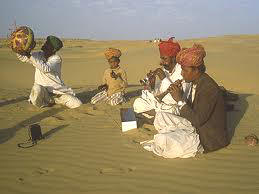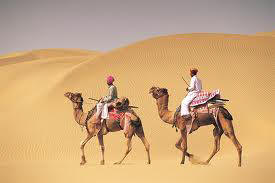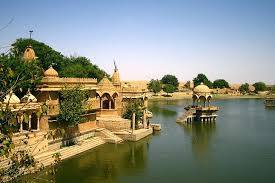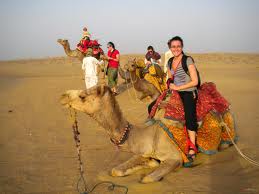|
Jaisalmer is one of the most loved towns of Rajasthan. As a
tourist destination, this city renders countless moments of
pleasure for the yearning tourist. The traditional warmth and
culture dominates the city of silvery sand dunes. The special
magic and aura that this city creates is another feather in its
cap. The city manages to sustain even during Brisith Raj and
Mughal dynasty.
Fairs & Festivals in Jaisalmer
Desert Festival ( JAN - FEB )
Once a
year in winters and on the middle of the continually rising and
falling stark yellow sands of the great Thar Desert, the empty
sands around Jaisalmer come alive with the brilliant colour, music
and laughter of the Desert Festival. The festival is organised by
the tourist authorities as tourist entertainment around
January-February. a
year in winters and on the middle of the continually rising and
falling stark yellow sands of the great Thar Desert, the empty
sands around Jaisalmer come alive with the brilliant colour, music
and laughter of the Desert Festival. The festival is organised by
the tourist authorities as tourist entertainment around
January-February.
The very rich and colourful Rajasthani folk culture is on show
here for a few days. Rajasthani men and tall beautiful women
dressed in their brightly costumes dance and sing lingering
ballads of valour, romance and tragedy. Traditional musicians
attempt to outdo each other in their musical superiority.
The high points of the festival are - snake charmers, puppeteers,
acrobats, folk performers do rapid trade. Camels, the lifeline of
the desert, play a foremost role. Proud moustached villagers,
dressed in their ethnic best come astride their picturesquely
caparisoned camels to join in the camel dances and competitions of
camel acrobatics, camel races and décor, camel polo, tug of war
and the like.
Places to see.
Havelis
The beautiful mansions built by Jaisalmer's wealthy merchants are
known as 'havelis' and several of these fine sandstone buildings
are still in beautiful condition. Patwon ki Haveli is the most
elaborate and magnificent of all the Jaisalmer havelis.
Jaisalmer Fort
The golden - yellow sandstone of Jaisalmer Fort, over 800 years
old, crowns the Trikuta Hill. Within its walls, defended by 99
turrets, lies the old city, nearly a quarter of modern Jaisalmer. 
Desert Festival
Held in the months of January-February, the Desert Festival exudes
a delightful spirit. For three days, the otherwise barren land of
Jaisalmer comes to life and is clustered with hordes of
colourfully dressed people.
Gadsisar Lake
Gadsisar Lake in Jaisalmer, the rainwater fed reservoir, was built
in 1156 AD and rebuilt in 1367AD by Maharwal Garsisingh.
Folklore Museum
For anyone interested in seeing the culture of Jaisalmer on
display through the ages, the Lok Sanskritik Sangrahalaya or the
Museum of Folk Culture situated on the bank of Gadsisar Lake in
Mehar Bagh Garden is a must.
 Gadsisar
Sagar Tank Gadsisar
Sagar Tank
Gadsisar Sagar is a scenic rain water lake with numerous beautiful
shrines around. The lake is an idyllic spot for outings and
picniking.
Jain temple
This group of fine Jain temples were built in the 12th to 15th
century within the Jaisalmer Fort. They are beautifully carved and
dedicated to Rishabdevji and Sambhavnathji.
Kailana Lake
Bookmark this page Printer friendly version Email this page
Located 11 kms off the Jaisalmer Road, Kailana Lake is a
picturesque lake. One can witness the spectacular sunsets and
cherish the beauty of the place. 
Camel Safaris
These are conducted on many routes.
Excursions from Jaisalmer
Sam Sand Dunes (42Km.)
Any trip to Jaisalmer is indeed, incomplete, without a trip to the
most panoramic dunes of Sam where the wind is unceasingly carving
out scenic patterns, on the sand! Situated 42 kms from Jaisalmer,
the sun-soaked Sam Sand Dunes bring to light a glided mirage.
Truly the essence of the desert, the ripples of the wind-caressed
dunes create an enchanting mirage.
Wood Fossil Park
Wood Fossil Park at Aakal, is 17-kms from the city of Jaisalmer.
Lying on the Barmer Road, this park transports you back to the
Jurassic period, when the whole Thar region lay under the sea. The
park with 180 million-year-old fossils that are the geological
landmarks for the study of the Thar Desert is any geology
enthusiast?s delight.
Bada Bagh (6Km.)
Only 3-km or so north of Jaisalmer, Bada Bagh is a fertile oasis,
with a huge old dam on the banks of an artificial lake. The
enchantingly scenic backdrop of a dainty lake and the dam in the
middle of the plateau, add to the beauty of the place.
Desert National Park (40Km.)
It preserves the eco-system of the desert within its confines. The
Monitor lizards, desert foxes, porcupines, occasional wolves and
black bucks, and the Great Indian Bustard (a protected bird ) are
found here, forming an ecological chain revolving around cactii
and other hardy desert plants. |